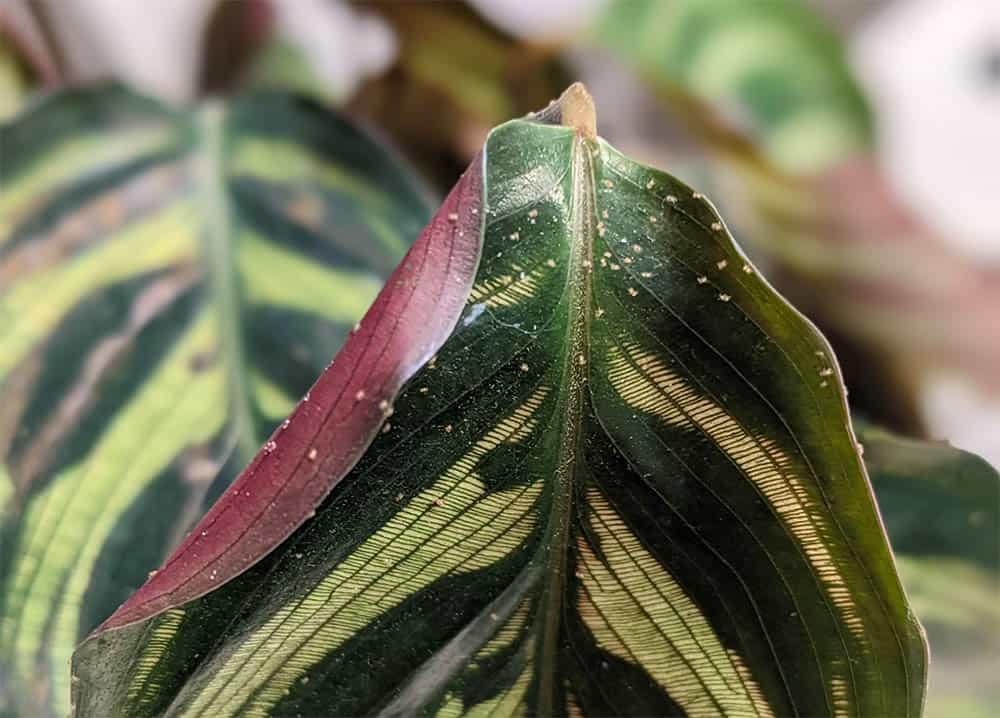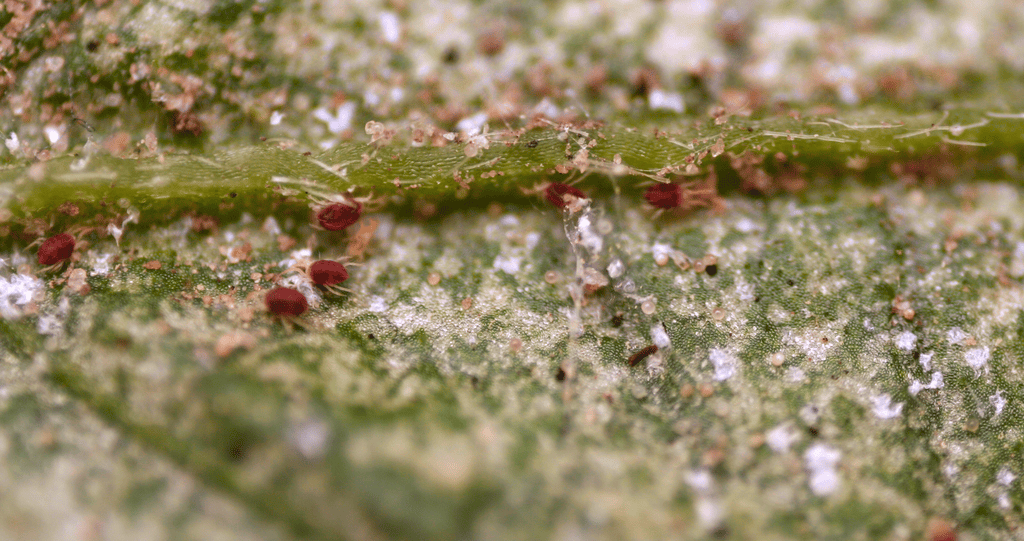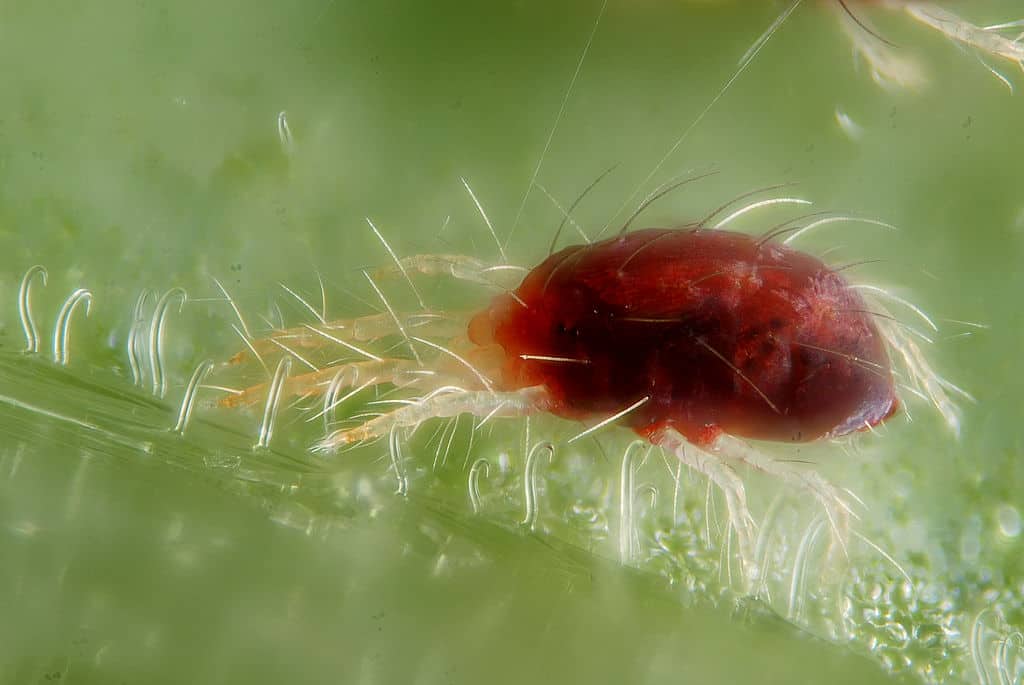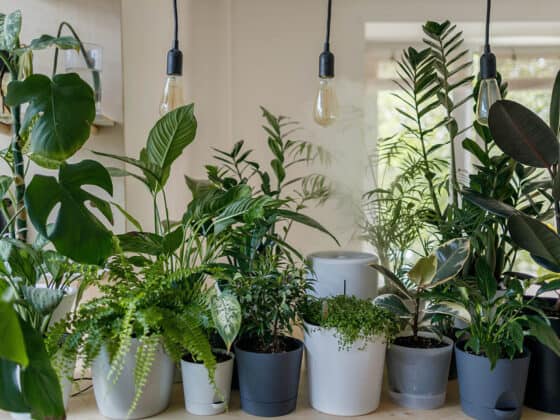Considered one of the more unsettling houseplant pests, mainly due to their name, spider mites can illicit some strong feelings. These tiny creatures are not only related to spiders, but they are prolific and persistent pests that can do a lot of damage to our plants when left to their own devices, leaving you to wonder what exactly these things are and how you get rid of them.
Spider mites are tiny arachnids that feed on plant sap by piercing through the soft tissue of a leaf or stem. They can cause significant damage to a plant, from discolored, stippled leaves to growth deformities and, occasionally, death. Plenty of treatment options can effectively eradicate them from your houseplant.
Knowing as much as you can about a houseplant pest is often the best way to make informed decisions about how to treat for them. In this article, we will answer the most commonly asked questions about spider mites so that you are equipped with good information to identify an infestation as early as possible and choose the treatment option that works best for you and your household.
If you are already an expert on all things spider mites and are just looking for a rundown of treatment options to try, our in-depth article can help.
What Are Spider Mites?
Spider mites are very small creatures (only about 1/50”) that live on a variety of indoor and outdoor plants. They are arachnids, technically related to spiders and ticks, so they have an oval-shaped body with eight legs protruding from it.

There are many different types of spider mites, but in most cases involving landscape or household plants, it is the two-spotted spider mite you are dealing with. This variety is usually greenish or translucent in color and has two dark spots on the back of its body. They can sometimes also be brown or an orangey-red color, as well.

Spider mites like to gather in protected spaces on an infested plant, which usually means you can find them in greater numbers on the underside of leaves and cluster in branched stems or flowering parts of a plant. They also produce fine webbing that can be seen stretching between leaves and stems or surrounding flowering plant parts.

Because of their tiny size, they often go unnoticed until their population grows large enough that the damage they inflict while feeding begins to take a toll on a plant’s health.
How Does a Houseplant Get Spider Mites?
Like many pests that get into our homes and infest houseplants, spider mites are most commonly introduced by hitching a ride indoors on our skin, clothing, or shoes. They are prolific pests outdoors that can easily attach to things that brush by them in the garden or a park. This means that pets can easily bring them inside, as well.
Another very common way spider mites can make it into our homes is by the introduction of new plants. Growers, nurseries, and plant shops all know to look out for possible spider mite infestations and are often very diligent about doing so. However, the fact of the matter is that because of their small size, a few spider mites can easily be missed during monitoring or treatment sessions.
It’s always a good idea to isolate any new houseplants you bring home for a few days to monitor for any potential bugs or diseases before you place them alongside the rest of your collection.
Can Spider Mites Live Without Plants?
Spider mites feed on the sugary sap most plants produce to transfer water and nutrients throughout their systems. They do this by piercing their needle-like mouth parts through the plant’s outer tissue and sucking the sap out. With plants being their primary habitat and sole food source, spider mites wouldn’t survive long without a host plant.
As part of their lifecycle, sometimes adult females will hunker down in the bark of a tree or shrub or down in some organic matter at the base of a plant to overwinter, but that is strictly to survive the weather until they can emerge during warmer temperatures and lay eggs to start a new population of mites.
Do Spider Mites Live In Soil?
The entirety of a spider mite’s lifecycle is lived on a plant. Eggs hatch into larvae, which go through two nymphal stages before they become new adults that can lay eggs again. The larvae, nymphs, and adults all feed on plant matter, and eggs are often laid in protected pockets of the plant or on the webbing the mites dispense.
Because no part of their lifecycle requires soil, there is no need for spider mites to drop down into the dirt. However, as was mentioned above, overwintering females may occasionally seek refuge from cold temperatures and severe weather down in barky soil if necessary, but that usually isn’t the case indoors, unless you keep your home really cold.
What Does Spider Mite Damage Look Like?
Because spider mites pierce the outer tissues of a plant’s leaves and stems, they do inflict damage in order to feed. However, because they are so small, a few bites from a spider mite won’t do much to your plant. But, if the population grows enough, all those tiny mites feeding throughout their entire lifecycle will add up to some significant damage.
Spider mite damage can be anything from a few spots of yellowing, and chlorotic tissue to stunted growth or even plant death. Likely, one of the first things you will notice is yellowing leaves, usually starting in patches near large veins. In some spots on the plant, feeding is heavy enough that tiny white dots are visible in large groupings, almost like the color was sucked right out of those areas.
Chronic spider mite feeding damage will give leaves a stippled, dull appearance, often accompanied by fine webbing covering large portions of a leaf. Leaves may begin to curl inward or drop from the plant completely, and any new growth may fill in stunted or deformed.
Do Spider Mites Kill Houseplants?
A few spider mites here and there aren’t going to be able to inflict enough damage to kill a houseplant. However, the thing about spider mites is that they have fast lifecycles and often go unnoticed for long periods of time due to their small size and knack for blending into the foliage.
Over time, as a population grows, the small amounts of damage begin to add up, and you start to see primary signs of an infestation, like yellowing leaves and webbing. Left untreated, the population can get large enough that a significant amount of damage begins to stress the plant and limits its ability to transport needed resources to all its different parts.
This is when you begin to see leaves dropping and growth stunting. With enough time, an untreated population of spider mites can do significant, unrepairable damage to a plant, which will eventually lead to its demise.
Can Spider Mites Live on or Bite Humans?
Spider mites tend to wig people out a bit more than some other houseplant pests. We get it…teeny tiny arachnids whose relatives are famous for biting things, including us? No, thank you!
The good news is that spider mites do not live on humans. Instead, they drink sap from plants as their food source, requiring a plant to survive. Plus, even if they did have a taste for human blood, their physiology prevents them from being a threat. Their tiny mouthparts would never be able to break through our thick human skin. So, relax! The worst a spider mite can do to you is use you as public transportation.
Do Spider Mites Move Fast?
Some more good news…spider mites are not really considered movers or shakers. Sure, they can move pretty fast for their size, but when you consider just how small they are, you can see how a few leaves of a plant might be their entire world.
Unlike fungus gnats, aphids, thrips, and whitefly, spider mites do not have wings at any point in their lifecycle, so for the most part, they are sequestered to a relatively small radius from where they are born. There really aren’t a lot of reasons why spider mites would need to travel very far from their home base unless they are looking for new feeding grounds.
Can Spider Mites Spread?
Spider mites generally stay put on their host plant and just carry on eating, breeding, and growing. If their food source begins to dry up or can’t otherwise sustain the growing population, they will go in search of other plants. They do this by walking.
More commonly found in nursery settings where plants are placed very close together, spider mites can spread from plant to plant by walking from one to another. Obviously, the farther plants are spaced out, the more unlikely it is that a spider mite will find new plants to infest.
In an indoor setting, it’s worth taking a look at how you have your houseplants spaced. If you’re like many people, you have some plants on their own and others in clusters. If a plant that is arranged alongside others gets infested by spider mites, there’s a good chance they will spread to neighboring plants, so it’s always a good idea to quarantine any plants you suspect to have a pest issue.
Also, remember that spider mites can be easily carried from one plant to another on clothing or by pets. Keep that in mind as you tend to your houseplants, making sure you stop touching other plants if you discover a spider mite infestation in one.
Do Spider Mites Go Away on Their Own?
Spider mites are persistent little buggers that will continue to feed on a plant as long as there is sap left to give. Because their lifecycle repeats rather quickly, especially in the warmer temperatures we keep our homes at, a population can get out of hand very fast.
At some point, a plant’s health will finally fail and will no longer be able to support the population of mites. This results in the spider mites either starving to death or seeking out a new food source in the form of another one of your houseplants.
Either way, it is better to quickly identify and treat a spider mite infestation to avoid these undesired outcomes.
Do Spider Mites Like Humidity?
Like thrips, spider mites prefer warmer, dryer conditions. As temperatures increase to around 80°F and above, their lifecycle speeds up, so larvae hatched from eggs can become adults within as little as 5-7 days. This can make a population explode within a matter of weeks.
Also, drier climates are better for spider mite mobility, so they can more easily carry out their tasks (mainly feeding, breeding, and laying eggs). Cooler, more humid temperatures slow everything down. Lifecycle times increase, individual growth slows, and wetter conditions can hinder mobility. This is obviously better for the plant, as well.
This is why, when you discover a spider mite problem, you should quarantine your houseplant in a cool, humid spot to help slow the growth of the population. Basements, spare bathrooms, or laundry rooms tend to be good spots. Even a garage will work well, depending on the time of year.
Should I Repot a Plant with Spider Mites?
You may have read articles about plant pests that advise you to repot your plant into fresh potting soil to help ease an infestation. In some cases, this advice can help, particularly when dealing with a really bad infestation of a bug that lives part of its life in the soil, like fungus gnats, for example.
However, when you discover you have a spider mite problem on one of your houseplants, remember that their entire lifecycle happens out of the soil and on the plant. Dealing with the issue quickly is a must, but repotting the plant isn’t necessary and could add to the stress your plant is already under. Skip the repotting and focus on knocking back the mite population instead.
How Do You Treat for Spider Mites?
Even though spider mites can be tricky little pests, the fact that their entire lifecycle is carried out on the plant actually simplifies the treatment options. Don’t worry about having to treat the plant and the soil both. You just have to pick a method you can carry out thoroughly, consistently, and repeatedly.
First and foremost, isolate an infested plant in a cool, humid area to avoid the pests spreading to any other houseplants. Spider mite treatment options fall into two general categories — physical removal or coverage.
Physical Removal
Physical removal of individual mites goes a long way in knocking back the population as long as you thoroughly treat all parts of the plant and are willing to repeat the treatment every few days until there are no more signs of spider mites.
Coverage Methods
Coverage methods typically refer to sprays or powders you can apply to the entire plant to coat every spider mite with an oil, chemical, or other substance that disrupts their normal functions and either suffocates, starves, or desiccates them.
Methods that fall into this category include spraying off mites with a water stream or wiping them away with a damp cloth. You can kick these methods up a bit by using soapy water or adding diluted rubbing alcohol to your cloth.
The key to coverage methods is, well, coverage! You want to make sure every mite comes into contact with whatever you are applying, knowing that any that are left untreated can reinfest the plant.
Things like Neem oil, insecticidal soaps, Spinosad, and Diatomaceous Earth all fall under the coverage category.
We discuss individual treatment options in depth if you want to learn more about the next steps.
Final Thoughts
Spider mites can be tricky, sneaky, and sometimes icky houseplant pests. They are often hard to identify early on, which means a good amount of damage can occur before we even realize there’s a problem. Hopefully, you have a better understanding of what spider mites are and how they operate, and you can use this information to make quick decisions on how to treat for them.
With a good plan of attack and a little follow-through, I’m confident you can control even the worst spider mite issue and have your houseplants living their best, pest-free lives. Good luck!















